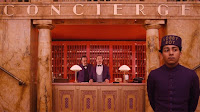Key Theory
Key Media Theory
Narrative Theory: Todorov created a theory in the late sixties, which he believed that it could be applied to any type of film. He believed that all films followed the same narrative pattern and it would fit into these stages:
Todorov created a theory in the late sixties, which he believed that it could be applied to any type of film. He believed that all films followed the same narrative pattern and it would fit into these stages:- Equilibrium - where we meet the characters at first Disruption - where something happens to affect the characters lives Realisation - where the characters realise they need to fix the situation/disruption (for example in the Grand Budapest Hotel, the characters are faced with harsh times after a death and the start of war and need to find a way to deal with this).

- Dis-equilibrium - the characters have to deal with the situation and often try to fix it (as the story continues, the characters then find a way to keep their hotel in fine order and keep the painting).

- New equilibrium - everything was restored back to the way it was or in a better place than what it was at the beginning. (In the ending, you find that the characters' situation had been resolved).
Barthes was a semiologist; he was paid to look at texts and decipher how they were pieced together. his idea was that texts could be open (unravelled in many different ways) or closed (theres is only one way it could be formed).
Barthes decided that these threads to pull on in order to unravel the meaning are called Narrative Codes. These include Action and Enigma Codes.
- Action Codes- These are significant events which move the narrative in a specific direction, it applies to any action that implies a further narrative action. For example, if you see someone draw their gun in a film, we wonder what the effect of this action will be.
- Enigma Codes- enigma codes pose questions to the audience which are then later answered further on in the film. They refer to any element in a story that is not explained and therefore, exists as an enigma for the audience, raising questions that demand an explanation.
Levi Strauss believed that the world was split into a series of binary opposites. this means that one thing can only be defined in relation to something that ins't. So for example, a hero is only seen as a hero because there is a villain there too.
Vladimir Propp developed a character theory for studying media texts and productions. He indicated that there are 7 broad character types within the 100 tales that he studied and analysed. He said that this could be applied to all media. these are the different character types -
1- The Hero- They are the major character in which the story revolves around.
2- The Villain- The sharpest contrast against the hero, typically morally bad, highlighting the goodness of the hero.
3- The Princess - She may be the object/person which is deliberately sought by the hero, perhaps finding where the villain has taken her or what he has done to her.
4- The Helper- The hero is supported in their quest by a helper, they appear at critical moments to provide support.
5- The Donor- They are the person who gives the hero something special (e.g. powers, a weapon, some wisdom).
6- The Dispatcher- An early role in the story that sends the hero on their mission.
7- The False Hero- A variant on the villain and a potential complication within the plot. While their motives may seem good at first, it become clear that they have villainous traits or are working with/for the villain.
Comments
Post a Comment